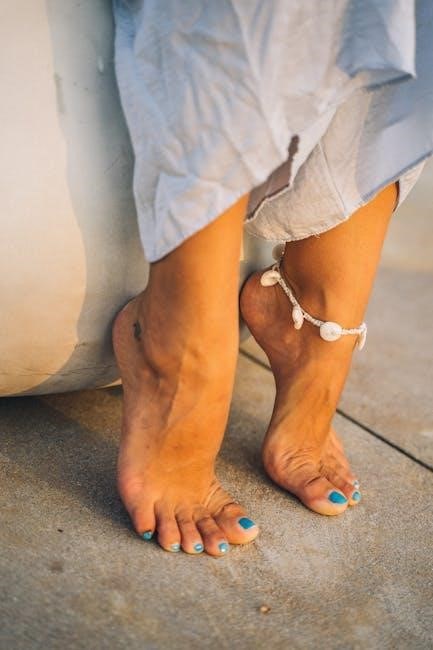
Paracord bracelets are stylish, durable, and functional accessories made from 550 paracord, offering survival benefits and customization options. They are a popular DIY project for crafters and outdoor enthusiasts.
1.1 What is a Paracord Bracelet?
A paracord bracelet is a versatile accessory made from durable 550 paracord, designed for both style and functionality. It serves as a practical survival tool, providing a reliable source of cordage in emergencies. Popular among outdoor enthusiasts and crafters, it combines strength and creativity, making it a functional and fashionable item for everyday wear or outdoor adventures.
1.2 Why Make a Paracord Bracelet?
Making a paracord bracelet offers both practicality and creativity. It provides a reliable emergency cordage source, ideal for outdoor adventures, while also serving as a stylish accessory; Crafting one allows for personalization, making it a fun and rewarding DIY project that combines functionality with self-expression, appealing to both enthusiasts and first-time crafters alike.
1.3 Benefits of a Paracord Bracelet
A paracord bracelet is durable, lightweight, and versatile, making it ideal for outdoor adventures. It serves as an emergency cordage source, a fashion accessory, and a customizable craft project. The 550 paracord material ensures strength, while its compact design makes it easy to carry. It also offers practical uses in survival situations, making it a valuable tool for any enthusiast.
Materials and Tools Needed
- 550 paracord (durable and ideal for bracelets)
- Buckle or clasp (for securing the bracelet)
- Scissors or knife (for cutting paracord)
- Lighter or fire source (to melt ends)
- Measuring tape or ruler (for accurate sizing)
2.1 Paracord (550 Paracord Recommended)
550 paracord is the ideal choice for bracelets due to its strength and durability. It consists of a braided nylon sheath with seven inner strands, capable of holding up to 550 pounds. This type of paracord is versatile, water-resistant, and perfect for both survival situations and stylish designs, making it a favorite among crafters and outdoor enthusiasts alike.
2.2 Buckle or Clasp
A sturdy buckle or clasp is essential for securing your paracord bracelet. Metal or plastic clasps are commonly used, offering durability and easy fastening. Some designs feature a shackle or side-release buckle, while others use a simple knot. Choose a buckle that complements your bracelet’s style and ensures a reliable closure for everyday wear or survival situations.
2.3 Scissors or Knife
Sharp scissors or a knife are necessary for cutting the paracord accurately. Ensure the tool is sharp to avoid fraying the cord. A clean cut is crucial for maintaining the integrity and appearance of your bracelet. Handle with care to prevent accidents and achieve precise cuts for a professional finish.
2.4 Lighter or Fire Source
A lighter or fire source is used to melt the ends of the paracord, preventing fraying and giving a clean finish. Use caution when handling fire to avoid burns. Gently heat the cut ends until they slightly melt and seal. This step ensures durability and a polished look for your bracelet.
2.5 Measuring Tape or Ruler
A measuring tape or ruler is essential for accurately determining your wrist size and calculating the required paracord length. Measure your wrist circumference to ensure a proper fit and use this measurement to estimate how much paracord you’ll need. This step guarantees your bracelet will be the right size and comfortable to wear.

Understanding Measurements
Accurate measurements are crucial for a well-fitting bracelet. Measure your wrist size, calculate the paracord length needed, and use examples to guide your calculations for the best results.
3.1 How to Measure Wrist Size
To measure your wrist size, use a flexible tape measure or a string. Wrap it snugly around the narrowest part of your wrist, just above the bone. Record the circumference in inches. For a comfortable fit, add 1-2 inches to this measurement. This will ensure your bracelet is neither too tight nor too loose, providing the perfect fit for your DIY project.
3.2 Calculating Paracord Length Needed
For every inch of wrist size, add 1 foot of paracord, plus an additional foot for weaving. For example, a 7-inch wrist requires 7 feet plus 1 foot, totaling 8 feet. This ensures enough material for knots and the chosen weave pattern, making it easy to follow step-by-step instructions and achieve a professional finish on your bracelet.
3.3 Example Calculation for Wrist Size
For a 7-inch wrist, multiply by 12 inches to convert to feet, then add 1 foot for knots, totaling 8 feet of paracord. This ensures the bracelet fits snugly and allows for a secure weave, making it both functional and stylish, perfect for following step-by-step guides and creating a durable accessory.

Step-by-Step Instructions
Start with a Lark’s Head Knot, then weave the paracord using the Cobra pattern. Tighten each knot securely, ensuring even tension. Finish by tucking the ends neatly.
4.1 Step 1: Create a Lark’s Head Knot
Begin by folding the paracord in half and securing it to a stable object. Form a loop at the folded end, then pass the working ends through it. Tighten the knot firmly to create the Lark’s Head foundation. This knot is essential for starting the bracelet and ensures a secure base for the Cobra Weave pattern to follow. Use a lighter to melt the ends for a clean finish.
4.2 Step 2: Begin the Cobra Weave
Take the right strand and cross it over the left, forming an “X” shape. Then, pass the right strand under the left and pull it through the loop. Repeat this process, alternating sides with each wrap. The Cobra Weave begins to take shape as you tighten each strand. Maintain even tension to ensure the bracelet lies flat and secure. This pattern is the foundation of the classic paracord bracelet design and provides both strength and style.
4.3 Step 3: Tighten the Knots
Once the Cobra Weave is started, gently pull both strands to tighten the knots. Ensure even tension to avoid unevenness. Use scissors or a knife to trim excess paracord and a lighter to melt the ends, preventing fraying. This step secures the bracelet’s structure, ensuring durability and a professional finish. Proper tightening is crucial for both functionality and aesthetic appeal.
4.4 Step 4: Finish the Bracelet
To complete the bracelet, create a loop on one end for the clasp. Tuck the paracord ends through the loop and pull tightly to secure. Trim excess cord with scissors or a knife, then use a lighter to melt the ends, preventing fraying. This step ensures a clean, professional finish and a secure closure for your paracord bracelet.
4.5 Step 5: Tuck the Ends
Tuck the loose ends of the paracord through the loop created in Step 4. Pull tightly to secure the bracelet. Trim any excess paracord with scissors or a knife. Use a lighter to carefully melt the cut ends, preventing fraying. This final step ensures a clean, professional finish and prevents the bracelet from unraveling over time.
Customizing Your Bracelet
Customize your paracord bracelet by choosing vibrant colors, adding unique knots, or incorporating accessories like beads or charms for a personalized and stylish finish.
5.1 Choosing Colors
Selecting the right colors for your paracord bracelet enhances its appeal and personalizes it. Consider matching your outfit or favorite hues. Earth tones are great for survival styles, while bright colors add a modern touch. Using multiple colors can create unique patterns. Choose colors that reflect your personality or serve a functional purpose, like camouflage or visibility.
5.2 Adding Additional Knots
Enhance your bracelet’s design and functionality by incorporating extra knots. The Cobra Weave is a popular choice, but you can explore decorative knots like the Diamond Knot or Tracer Knot for visual interest. These knots not only add texture but also create a more intricate, personalized look. Experiment with different patterns to make your bracelet truly unique and showcase your craftsmanship.
5.3 Incorporating Accessories
Elevate your paracord bracelet by adding accessories like beads, charms, or metal clasps. These elements enhance both functionality and style. For instance, beads can add color accents, while a metal clasp provides a secure closure. You can also integrate whistle or compass beads for survival purposes, making your bracelet not only fashionable but also practical for outdoor adventures. Personalize it to reflect your unique style or needs.
Safety Precautions
Always handle sharp tools like scissors or knives with care to avoid injuries. When using fire to melt paracord ends, ensure a safe environment to prevent burns.
6.1 Handling Sharp Objects
When using scissors, knives, or other sharp tools, always cut away from your body. Ensure blades are sharp to avoid accidents and use a stable cutting surface. Keep fingers away from the cutting edge and consider using protective gloves; Supervise children and store sharp objects safely when not in use.
6.2 Using Fire Safely
When using a lighter or fire source to melt paracord ends, keep the flame away from your body. Work in a well-ventilated area, avoid loose clothing, and never leave the fire unattended. Ensure no flammable materials are nearby. Be cautious with the flame’s intensity to prevent burns or accidents, and extinguish it immediately after use.

Troubleshooting Common Issues
Common issues include uneven tension, knots coming undone, or incorrect length. Check for loose strands, re-tighten knots, and ensure accurate measurements for a proper fit.
7.1 Uneven Tension
Uneven tension is a common issue, causing knots to loosen or the bracelet to feel tight in some areas. To fix this, gently pull the paracord strands to tighten any loose sections. Ensure even pressure while weaving to prevent unevenness. If needed, use a lighter to slightly melt and reshape the paracord ends for a smoother finish and consistent tension throughout the bracelet.
7.2 Incorrect Length
Incorrect length can make the bracelet too tight or too loose. To fix this, remeasure your wrist and recut the paracord accordingly. A general rule is to add 1 foot of paracord for every inch of wrist size. For example, a 7-inch wrist requires 8 feet of paracord. Ensure accurate measurements before cutting to avoid resizing later.
Downloadable PDF Guide
A downloadable PDF guide provides step-by-step instructions for crafting paracord bracelets, including photos and tutorials. Print it for easy offline access and crafting on the go.
8.1 Accessing the PDF Tutorial
To access the PDF tutorial, visit the provided link and download the file. Ensure your device supports PDF viewing. Print the guide for offline use and follow the step-by-step instructions, including photos and detailed diagrams. The PDF covers materials, measuring, and weaving techniques, making it easy to craft a paracord bracelet at home. Troubleshooting tips are also included for common issues.
8.2 Printing and Using the Guide
Print the PDF guide on standard paper for easy reference. Follow the step-by-step instructions, photos, and diagrams to craft your bracelet. Ensure your printer settings maintain the document’s original size for clarity. Use the guide to organize materials, measure wrist size, and master weaving techniques. Keep it handy for quick troubleshooting and to ensure accurate knot placement during the crafting process.

Additional Resources
Explore downloadable PDF guides, YouTube tutorials, and creative paracord projects beyond bracelets, such as keychains, pet collars, and more for diverse crafting inspiration and skill enhancement.
9.1 YouTube Tutorials
YouTube offers a wealth of step-by-step paracord bracelet tutorials, providing visual guides for various styles, including the Cobra and Solomon weaves. These videos often include tips for customization, troubleshooting, and advanced techniques. Many creators share detailed instructions, making it easier for beginners to follow along. Search for specific designs or techniques to enhance your crafting skills and create polished, professional-looking bracelets.
9.2 Other Paracord Projects
Beyond bracelets, paracord can be used for various creative projects, such as keychains, bag straps, and pet collars. Many enthusiasts also craft dog toys, survival whistles, and even home decor items like plant holders. These projects often utilize the same knots and techniques as bracelets, making them excellent ways to practice and expand your paracord crafting skills while creating functional or decorative items.
Thank you for following this guide! With these step-by-step instructions and resources, you’re ready to craft your own paracord bracelet. Happy crafting!
10.1 Final Tips
Mastering paracord bracelet crafting takes patience and practice. Start with simple knots like the Lark’s Head and Cobra Weave. Experiment with colors and patterns to personalize your designs. Always keep extra paracord on hand for adjustments. Don’t hesitate to reference online tutorials or PDF guides for visual guidance. Most importantly, enjoy the creative process and share your creations with others!
10.2 Encouragement to Start Crafting
Embarking on paracord bracelet crafting is a rewarding journey! With simple tools and step-by-step guides, even beginners can create stunning, functional designs. Don’t be afraid to experiment and make mistakes—it’s part of the learning process. Each bracelet you craft is a testament to your creativity and skill. Dive in, enjoy the process, and soon you’ll be creating stylish, durable paracord accessories with ease!
Leave a Reply
You must be logged in to post a comment.